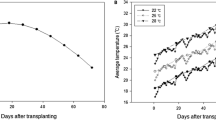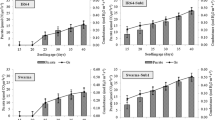Abstract
Previous studies suggest that the positive response of transplanted rice (Oryza sativa L.) to nursery fertiliser application was due to increased seedling vigour or possibly to increased nutrient content. This paper presents results of two glasshouse experiments designed to test the hypothesis that seedling vigour was responsible for the response of transplanted seedlings to nursery treatments. The aim of the present study was to explore the concept of seedling vigour of transplanted rice and to determine what plant attributes conferred vigour on the seedlings. Seedling vigour treatments were established by subjecting seedlings to short-term submergence (0, 1 and 2 days/week) in one experiment and to leaf clipping or root pruning and water stress in another to determine their effect on plant growth after transplanting. Submerging seedlings increased plant height but depressed shoot and root dry matter and root:shoot ratio of the seedling at 28 days after sowing. After transplanting these seedlings, prior submergence depressed shoot dry matter at 40 days. Nursery nutrient application increased plant height, increased root and shoot dry matter, but generally decreased root:shoot ratio. Pruning up to 60% of the roots at transplanting decreased shoot and root dry matter, P concentration in leaves at panicle initiation (PI) and straw dry matter and grain yield at maturity. By contrast, pruning 30% of leaves depressed shoot and root dry matter by 30% at PI, and root dry matter and straw and grain yield by 20% at maturity. The combined effects of leaf clipping and root pruning on shoot, root and straw dry matter were largely additive. It is concluded that the response of rice yield to nursery treatments is largely due to increased seedling vigour and can be effected by a range of nutritional as well as non-nutritional treatments of seedlings that increase seedling dry matter, nutrient content, and nutrient concentration. Impairment of leaf growth and to a lesser extent root growth in the nursery depressed seedling vigour after transplanting. However, rather than increasing stress tolerance, seedling vigour was more beneficial when post transplant growth was not limited by nutrient or water stresses.
Similar content being viewed by others
References
Adkins SW, Shiraishi T and McComb JA 1990 Submergence tolerance of rice – a new glasshouse method for the experimental submergence of plants. Physiol. Plant. 80, 642–646.
Asch F, Sow A and Dingkuhn M 1999 Reserve mobilization, dry matter partitioning and specific leaf area in seedlings of African rice cultivars differing in early vigor. Field Crops Res. 62, 191–202.
Ashraf M and Zia M S 1980 Effect of trimming leaves and roots of rice seedlings on plant growth characteristics and paddy yield. Pakistan J. Agric. Res. 18 (1), 35–36.
Association of Official Seeds Analysts 1988 Rules for testing seeds. J. Seed Technol. 12, 1–117.
Biddington N L and Dearman A S 1984 Shoot and root growth of lettuce seedlings following root pruning. Ann. Bot. 53, 663–668.
Das G R and Ahmed T 1989 Effect on rice yield of root damage to seedlings. Int. Rice Res. Newslett. 14(6), 5–6.
Jackson M B, Waters I, Setter T and Greenway H 1987 Injury to rice plants caused by complete submergence – a contribution by ethylene (ethene). J. Exp. Bot. 38, 1826–1838.
Khiev B, Jahn G C, Pol C and Chhorn N 1999 Simulating pest damage to determine effects on rice yields. Cambodian J. Agric. 2, 29–31.
Maskina M S, Meelu O P and Baddesha H S 1985 Effect of injured seedling root on rice yield. Int. Rice Res. Newslett. 10 (6), 31.
Matsuo T and Hoshikawa K 1993 Science of the rice plant. Vol 1. Morphology. Food and Agricultural Policy Research Center, Tokyo, Japan. pp. 686.
Matsuo T, Kumazawa K, Ishii R, Ishihara K and Hirata H 1995 Science of the rice plant. Vol 2. Physiology. Food and Agricultural Policy Research Center, Tokyo, Japan. pp. 1240.
Mazaredo A M and Vergara B S 1982 Physiological differences in rice varieties tolerant of and susceptible to complete submergence. In Proceedings of the 1981 International Deepwater Rice Workshop. The International Rice Research Institute. Los Baños, Manila, Philippines.
Mukherji D K 1973 Effect of pruning rice seedlings on growth and yield. Sci. Cult. 39 (4), 198–199.
Panda M M, Reddy, M D and Sharma A R 1991 Yield performance of rainfed lowland rice as affected by nursery fertilization under conditions of intermediate deepwater (15–50 cm) and flash floods. Plant Soil 132, 65–71.
Pfister-Sieber M and Brandle R 1994 Aspects of plant behaviour under anoxia and post-anoxia. Proc. R. Soc. Edinburgh 102B, 313–324.
Raskin I and Kende H 1984 Regulation of growth in stem sections of deep-water rice. Planta 160, 66–72.
Reddy M D and Mittra B N 1985 Effect of complete plant submergence on vegetative growth, grain yield and some biochemical changes in rice plant. Plant Soil 7, 365–374.
Richards D and Rowe R N 1977 Effect of root restriction, root pruning and 6-benzylaminopurine on the growth of peach seedling. Ann. Bot. 41, 729–740.
Ros C 1998 Management of Seedling Nutrition in Lowland Rainfed Rice. Ph D thesis, Murdoch University, Western Australia.
Ros C, Bell R W and White P F 1997 Nursery applications of N and P increase Rice (Oryza sativa) yield. Kasetsart J. Nat. Sci. 31, 96–105.
Ros C, White P F and Bell R W 1998 Field survey on nursery and mainfield fertiliser management. Cambodian J. Agriculture 1, 22–33.
Ros C, Bell R W and White P F 2000 Phosphorus seed coating and soaking for improving seedling growth of Oryza sativa (rice) cv. IR66. Seed Sci. Technol. 28, 201–211.
Shalaby Y Y, Kobbia T E and Omar M A 1969 Rice yield as influenced by N-fertilization in nursery. J. Soil Sci. U.A.R. 9(2), 185–199.
TeKrony D M and Egli D B 1991 Relationship of seed vigour to crop yield: A review. Crop Sci. 31, 816–822.
Varley J A 1966 Automatic methods for the determination of nitrogen, phosphorus and potassium in plant material. Analyst 91, 119–126.
White P F, Nesbitt H J, Ros C, Seng V and Pheav S 1995 Granulation and formulation of local rock phosphate deposits: a potential boon for Cambodia. Agro-chemicals News in brief, ESCAP/FAO/ UNIDO 18, 26–31.
Zarcinas B A, Cartwright B and Souncer C R 1987 Nitric acid digestion and multielement analysis of plant material by inductively coupled plasma spectrometry. Commun. Soil Sci. Plant Anal. 18, 131–146.
Author information
Authors and Affiliations
Corresponding author
Rights and permissions
About this article
Cite this article
Ros, C., Bell, R.W. & White, P.F. Seedling vigour and the early growth of transplanted rice (Oryza sativa). Plant and Soil 252, 325–337 (2003). https://doi.org/10.1023/A:1024736104668
Issue Date:
DOI: https://doi.org/10.1023/A:1024736104668




